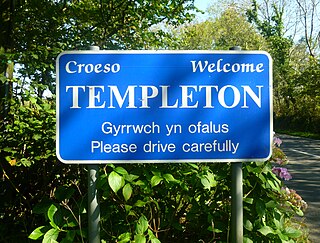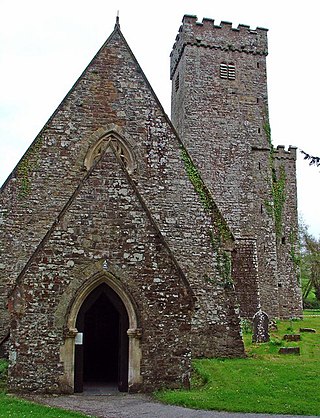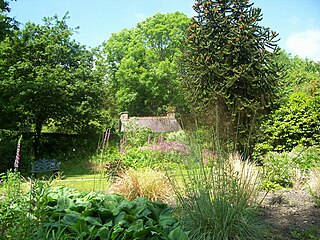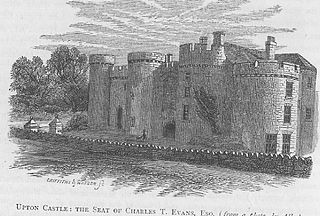
The Pembrokeshire Coast Path, often called the Pembrokeshire Coastal Path, is a designated National Trail in Pembrokeshire, southwest Wales. Established in 1970, it is a 186-mile (299 km) long-distance walking route, mostly at cliff-top level, with a total of 35,000 feet (11,000 m) of ascent and descent. At its highest point – Pen yr afr, on Cemaes Head – it reaches a height of 574 feet (175 m), and at its lowest point – Sandy Haven crossing, near Milford Haven – it is just 6 feet (2 m) above low water. Whilst most of the coastline faces west, it offers – at varying points – coastal views in every direction of the compass.

Ruthin is a market town and community in Denbighshire, Wales, in the south of the Vale of Clwyd. It is Denbighshire's county town. The town, castle and St Peter's Square lie on a hill, skirted by villages such as Pwllglas and Rhewl. The name comes from the Welsh rhudd (red) and din (fort), after the colour of sandstone bedrock, from which the castle was built in 1277–1284. The Old Mill, Ruthin, is nearby. Maen Huail, a registered ancient monument attributed to the brother of Gildas and King Arthur, stands in St Peter's Square.

Nevern is both a parish and a community in Pembrokeshire, Wales. The community includes the settlements of Felindre Farchog, Monington, Moylgrove and Bayvil. The small village lies in the Nevern valley near the Preseli Hills of the Pembrokeshire Coast National Park 2 miles (3 km) east of Newport on the B4582 road.

Eccleshall is a town and civil parish in the Stafford district, in the county of Staffordshire, England. It is located seven miles northwest of Stafford, and six miles west-southwest of Stone. Eccleshall is twinned with Sancerre in France.

Amroth is a village, parish and community 7 miles (11 km) northeast of Tenby, Pembrokeshire, Wales. Located on Carmarthen Bay, Amroth is noted for its long sandy beach which stretches the length of the village. It regularly earns a Blue Flag award. and is the south-to-north start of the Pembrokeshire Coast Path. Amroth is within the Pembrokeshire Coast National Park.

Saundersfoot is a large village and community in Pembrokeshire, Wales. It is near Tenby, both being holiday destinations. Saundersfoot lies in the Pembrokeshire Coast National Park and on the Pembrokeshire Coast Path. The village population was 3,361 in 2011. while the community had a population of 2,628.

Picton Castle is a medieval castle near Haverfordwest in the community of Uzmaston, Boulston and Slebech, Pembrokeshire, Wales. Originally built at the end of the 13th century by a Flemish knight, it later came into the hands of Sir John Wogan. The castle and estate are now run by the Picton Castle Trust, a registered charity, and are no longer occupied by Wogan's descendants, the Philipps family. It is of unusual construction and has been remodelled several times during its history. The castle is a Grade I listed building and its gardens and park are designated at Grade II* on the Cadw/ICOMOS Register of Parks and Gardens of Special Historic Interest in Wales.

St Brides is a parish and small coastal village in Pembrokeshire, Wales, at the south of St Brides Bay, about 1+1⁄2 miles (2.4 km) north of the larger village of Marloes, with which it forms the Marloes and St Brides community.

Treago Castle is a fortified manor house in the parish of St Weonards, Herefordshire, England. Built c. 1500, it was recorded as a Grade I listed building on 30 April 1986—based on its extant medieval architecture, quadrangle courtyard layout and defensive wall corner towers. Digging on the site revealed solid bedrock, conflicting rumours of a previously filled moat.

Templeton is a village and community in Pembrokeshire, Wales. The population of the community was 943 in 2011. The built-up area had a population of 627.

Llawhaden is a village, parish and community in the Hundred of Dungleddy, Pembrokeshire, West Wales. The community of Llawhaden includes the parish of Robeston Wathen, part of Narberth and the hamlet of Gelli, and had a population of 634 in 2001, increasing to 688 at the 2011 Census.
Eglwyswrw is a village, community and parish in the former Cantref of Cemais, Pembrokeshire, Wales. The village lies between Newport and Cardigan at the junction of the A487 road and the B4332 at an altitude of 130 metres (430 ft).

Coupland Castle is situated in the village of Coupland, 4 miles (6 km) to the north-west of Wooler, Northumberland, England. It is a Grade I listed building. The Grade I listed "castle" is actually a tower house "built after 1584, with irregular later additions".

Owen Cosby Philipps, 1st Baron Kylsant, known as Sir Owen Philipps between 1909 and 1923, was a British businessman and politician, jailed in 1931 for producing a document with intent to deceive.

Colby Woodland Garden is a National Trust woodland garden in a secluded valley, approximately ¾ of a mile north of Amroth in Pembrokeshire, Wales. It is listed on the Cadw/ICOMOS Register of Parks and Gardens of Special Historic Interest in Wales.

Caludon Castle is a Scheduled Ancient Monument and Grade I listed building in Coventry, in the West Midlands of England. A second moated site 190 metres (620 ft) to the south is a Scheduled Ancient Monument in its own right. The castle is now a ruin, and all that remains is a large fragment of sandstone wall. What remains of the estate is now an urban park, owned and run by Coventry City Council, but much of it was sold and developed into housing estates in the early 20th century.

Newport Castle is a castle located in Newport, Pembrokeshire, Wales. The earliest castle on the site was built in the 13th century, and the present structure was built in the 19th century and is a private residence.
Warner Leisure Hotels is a hospitality company owning 14 country and coastal properties around the UK in North Wales, Somerset, Herefordshire, Berkshire, North Yorkshire, Nottinghamshire, Isle of Wight, Suffolk, Hampshire and Warwickshire. Founded in 1932 as Warner Holiday Camps, later known as Warner Holidays and has been adult only since 1994. In the 1990s Warner's started developing country house hotels and changing their existing 'camps' into coastal resorts and hotels.

Upton Castle is a 13th-century castle or fortified manor house with an associated chapel, located near Cosheston, Pembrokeshire in Wales. Although in private ownership, the gardens are open to the public. They are listed on the Cadw/ICOMOS Register of Parks and Gardens of Special Historic Interest in Wales.

St Brides Castle is a 19th-century castellated baronial-style mansion in the parish of St Brides and the community of Marloes and St Brides, Pembrokeshire, southwest Wales.


















